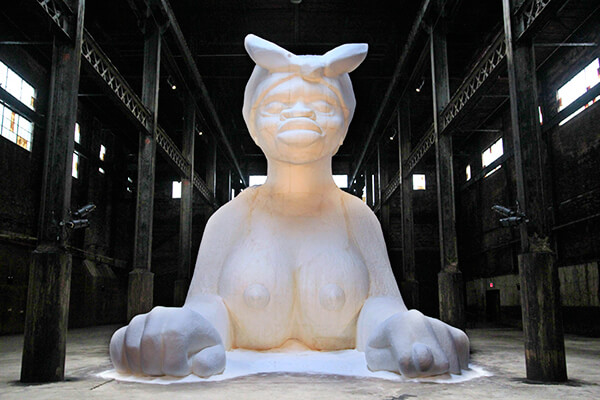White People Problems: On Kara Walker and the Way White People Interact with Black Art


photo by Austin McAllister
The scent alone is enough to stop you in your tracks, the way the strong, sweet smell of molasses permeates the air around the old Domino Sugar Refinery instantly overwhelms anyone passing by with what could be considered the ultimate sugar rush. But it isn’t until you wend your way through the at times hours-long line and are confronted with the source of that scent that your senses are truly subsumed.

Not dissimilarly to Walker’s other work, “A Subtlety” is anything but subtle; much of its power lies in its bold reappropriation of images of black women and its insistence that viewers acknowledge the power and the pain behind what they are consuming for what can best be described as pleasure. Because pleasure is the driving reason behind most people’s consumption of art—even when the work is known to tackle a painful subject, nobody ever said pain wasn’t its own kind of pleasure. But with this specific work, there is a different kind of pleasure at play, namely, that because Walker’s installation has been much-lauded and talked about, and because it’s located in the Domino Sugar Refinery in Williamsburg, and because if there’s one thing New Yorkers and people who want to look like New Yorkers can’t resist it’s a long line, seeing “A Subtlety” has become a New York experience akin to buying a Cronut or braving the Madison Square Park Shake Shack line.
And just like Cronut and Shake Shack crowds, many of the people who are going to see Walker’s work are just about the worst kind of people possible. How bad? Well, as revealed in a recent post on Gawker titled “The Audacity of No Chill: Kara Walker in the Instagram Capital,” pretty damn terrible. Stephanye Watts, the author of the post, relates her own experience at the installation and her disgust with many of her fellow visitors, who used the opportunity to “yell ‘Sugar tits!’ ‘Hey, did you get a picture of the lips? Those sweet lips!’ and ‘That’s a big ass!'” and take “photo ops, which ranged from the Munch/Home Alone ‘Scream’ face to sexually inappropriate.” After leaving the installation, Watts was further outraged by the discovery of countless offensive Instagram posts that objectified Walker’s sphinx, and dismissed claims that this type of behavior should be condemned, though ultimately excused, as simply part of white privilege. “Like a fool,” Watts says, “I expected all adults involved to act like, I dunno, adults?”
The problem is, though, that this is exactly how “adults” have acted for generations and it is this very type of “adult” behavior which is at the root of our society’s ability to dehumanize groups of people based on nothing but the color of their skin in order to profit off their pain. And, in fact, this type of despicable behavior by white patrons is undoubtedly something that Walker knew would happen and is part of what makes her work so effective. The not so subtle message in Walker’s work is that not all that much has really changed in our society; we are still collectively invested in the objectification and diminishment of minorities—black women in particular.
In an excellent essay on Colorlines, Jamilah King wrote about “the overwhelming whiteness of black art,” and how the majority of museum-goers—even to black artists’ exhibits—are white and wealthy. King writes, “it’s reassuring that so many white people have a vested—or at least passing—interest in consuming art that deals with race. At the same time I found it unsettling to view art by a black artist about racism in an audience that’s mostly white. It reinforced the idea that black people’s histories are best viewed but not physically experienced.” But the very nature of “A Subtlety” forces interaction with black history, making the white response to it a part of the work of art itself. And while many—probably a majority—of the white people who have gone to see Walker’s exhibit have been appropriately respectful of the work, the mere fact that countless others have no reverence and no care for the message behind the piece is as fascinating as it is distressing and is what takes Walker’s work out of the realm of excellence and into the realm of brilliance. It is not enough to see Walker’s “A Subtlety” and only look at the sphinx. Part of the power of the work is to look at the people interacting with it and realizing that no matter how far we’ve come, we’ve still got a long way to go. And that, more than the sickeningly sweet smell of sugar, is what will stay with you long after you leave the factory.
Follow Kristin Iversen on twitter @kmiversen
You might also like 




















